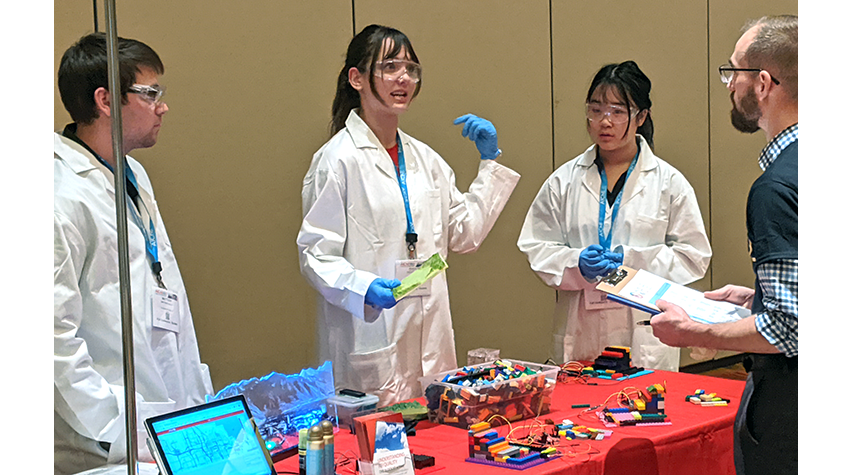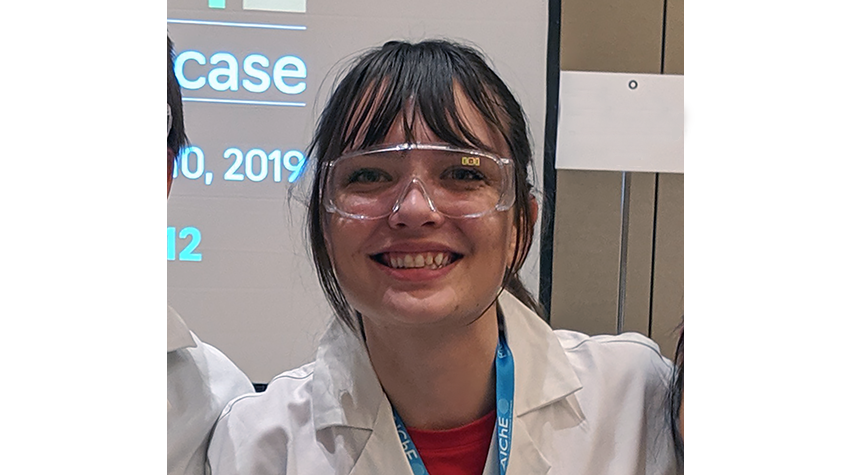
Photo: Shaylee Larson (center) explains the University of Utah’s entry, “Air Quality Data Visualization,” to a contest judge during AIChE’s 2019 K-12 STEM Outreach Competition.
In the summer 2021 issue of the K-12 Committee Newsletter, the committee introduces readers to Shaylee Larson, a student at the University of Utah. Shaylee talked about her experience in K–12 activities organized by the university’s AIChE student chapter. She also told us what inspired her to become an engineer, and how her student group plans to bring STEM events to even more students.
At AIChE’s 2019 K–12 STEM Outreach Competition, Larson and her undergraduate colleagues at the University of Utah’s AIChE Student Chapter won first prize in the professional competition with their K–12 activity “Air Quality Data Visualization.” The classroom demonstration showed students how to use toy building blocks and a few basic electronic components to build a simple air quality sensor. The team’s winning module is available in an archive accessible by members of AIChE’s K–12 Community.
I’m from a relatively small, isolated town, and from what I’ve heard, our exposure to things like outreach was dramatically restricted when compared to my peers who grew up in metropolitan areas...
Shaylee, who will begin her senior year at Utah this fall, has been very active in the K–12 community. She attributes her motivation to contribute to K–12 outreach to her own K–12 years, when college students visited her high school. The outreach activities she attended in high school enabled her to decide her major in college. Early involvement in STEM is now helping her to pave her own path, and her activities with the University of Utah chapter allow her to help inspire for the next generation of budding engineers.
“I really enjoyed one event we did at Adobe,” said Larson, referring to a program in which the software company Adobe has partnered with education agencies in Utah to stimulate creative learning among K–12 students. “We were presenting to students in rotations, meaning we engaged with hundreds that day. Seeing their eyes light up every time our team brought out a human-powered turbine, or seeing their hands shoot up when we asked who wanted to help us generate thermoelectric power, made it a really rewarding time for everyone involved.”

For Shaylee, outreach events also provide a much needed break from the stresses of school. And although outreach activities can be time consuming, she finds the impact to be very rewarding.
One area where that impact is seen most distinctly is when working with disadvantaged school districts, although Shaylee says that those situations can pose challenges. One particular challenge she has faced reaching underserved students who often need it most is the extra coordination required by K–12 teachers in those communities. If the teacher’s time is already being stretched thin, it can be difficult for the outreach team to schedule and coordinate a visit, says Shaylee. However, Shaylee’s AIChE chapter is dedicated to working with those teachers in order to be as helpful as possible.
Shaylee feels that hands-on outreach events are the most impactful, although she notes that budgets may sometimes be a concern. When possible, Shaylee recommends letting students build a module of their choosing from scratch and letting students take it home. For example, in the case of her team’s air quality visualization module, Shaylee says, “Not only would circuiting and assembling a mobile photometer help their understanding of how it worked, but being able to keep it would allow them to experiment with samples at home that they were curious about. And they can show it to their friends.”
When asked about how the impact of K–12 outreach can be improved, Shaylee said that more attention should be paid to students in rural communities. “I’m from a relatively small, isolated town, and from what I’ve heard, our exposure to things like outreach was dramatically restricted when compared to my peers who grew up in metropolitan areas,” says Shaylee. “So, every year, our team does a trip to a smaller, rural area to show our modules — and it ends up being one of the most exciting things the students of that area see that semester.”

